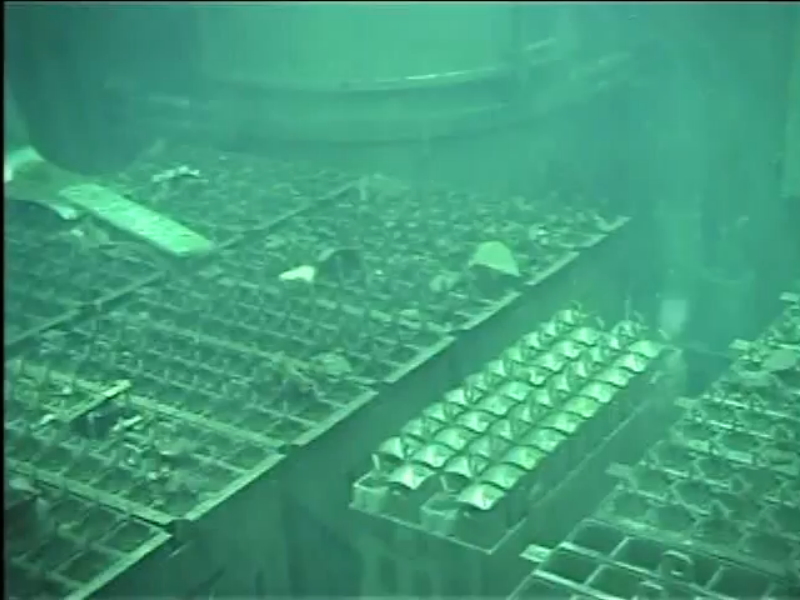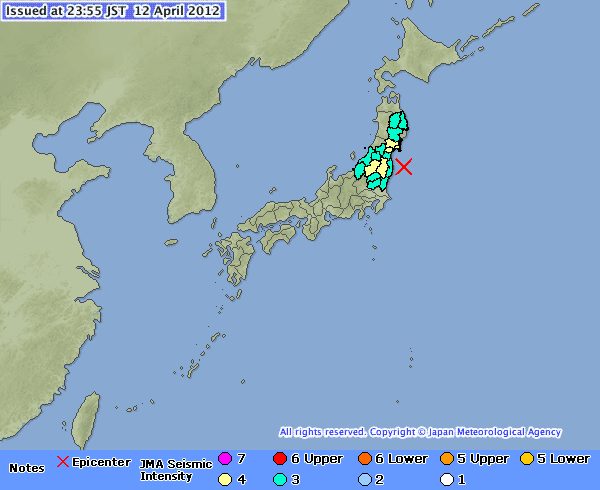The greatest single threat to humanity – Fukushima nuclear reactor no. 4 raises new global worries

Japan’s former Ambassador to Switzerland, Mr. Mitsuhei Murata, was invited to speak at the Public Hearing of the Budgetary Committee of the House of Councilors on March 22, 2012, on the Fukushima nuclear power plants accident.
Before the Committee, Ambassador Murata strongly stated that if the crippled building of reactor unit 4 — with 1,535 fuel rods in the spent fuel pool 100 feet (30 meters) above the ground — collapses, not only will it cause a shutdown of all six reactors but will also affect the common spent fuel pool containing 6,375 fuel rods, located some 50 meters from reactor 4.
In both cases the radioactive rods are not protected by a containment vessel; dangerously, they are open to the air.
The greatest single threat to humanity
This would certainly cause a global catastrophe like we have never before experienced. He stressed that the responsibility of Japan to the rest of the world is immeasurable. Such a catastrophe would affect us all for centuries.
It is no exaggeration to say that the fate of Japan and the whole world depends on NO.4 reactor. This is confirmed by most reliable experts like Dr. Arnie Gundersen or Dr. Fumiaki Koide. Mr. Mitsuhei Murata in a letter to Ban Ki-moon

While the first three reactors contained fuel and presented a serious threat since March 11, 2011, they have largely been contained. Reactor 4 contained no fuel when the earthquake hit. Instead, the spent fuel rods had been moved to a cooling pool on the second floor of the containment unit. The unit suffered enormous damage during the tsunami—a hydrogen explosion blew the roof off, leaving the highly radioactive fuel pool exposed to the open air. If another high level earthquake hits the area, the building will certainly collapse. Japanese and American meteorologists have predicted that such a strong earthquake is indeed likely to hit this year.
The meltdown and unprecedented release of radiation that would ensue is the worst case scenario that then-Prime Minister Kan and other former officials have discussed in the past months. He warned during his speech at the World Economic Forum in Davos that such an accident would force the evacuation of the 35 million people in Tokyo, close half of Japan and compromise the nation’s sovereignty. Such a humanitarian and environmental catastrophe is unimaginable. Hiroshi Tasaka, a nuclear engineer and special adviser to Prime Minister Kan immediately following the crisis, said the crisis “just opened Pandora’s Box.” (akiomatsumura.com)
Whole Northern Hemisphere at risk – interview with Dr. Arnie Gundersen
Alex Smith, of Radio Ecoshock, interviewed nuclear industry expert Arnie Gundersen, of Fairewinds Associates. Smith notes that the nuclear accident at Fukushima Japan is far from over as three reactors continue to meltdown. Smith adds that now there is a storm of international worry about nuclear fuel pools tottering in blown up buildings putting the whole Northern Hemisphere at risk.
Gundersen is chief engineer of Fairewinds Associates, an energy consulting company. He previously worked for Nuclear Energy Services in Danbury, a consulting firm where he was a senior vice president. Gundersen holds a master’s degree in nuclear engineering.


Gundersen says it is unlikely there would be an explosion if the #4 Fuel pool collapses. But dangerous “hot” particles would still be sent around the world, because within two days of the collapse, the Zirconium and radioactive metals (like Cesium and Plutonium) would burn at a very high temperature, sending particles high into the air. The result would be an everlasting disaster for Japan. Arnie thinks it could create a no-man’s land 50 miles across the country, perhaps destabilizing the government.
According to Smith, “Arnie Gundersen, a year ago, warned us on Radio Ecoshock, and to anybody who would listen, that a world-scale catastrophe was lurking in the nuclear fuel storage pools of both reactors Three and Four, at the Fukushima Daiichi plant in Japan. Why is this story finally getting wider attention, a year later?”
Mainichi Expert Sr. Writer: Gov’t sources say No. 4 pool a grave concern
The storage pool in the No. 4 reactor building has a total of 1,535 fuel rods, or 460 tons of nuclear fuel, in it. The 7-story building itself has suffered great damage, with the storage pool barely intact on the building’s third and fourth floors. The roof has been blown away. If the storage pool breaks and runs dry, the nuclear fuel inside will overheat and explode, causing a massive amount of radioactive substances to spread over a wide area. Both the U.S. Nuclear Regulatory Commission (NRC) and French nuclear energy company Areva have warned about this risk.
A report released in February by the Independent Investigation Commission on the Fukushima Daiichi Nuclear Accident stated that the storage pool of the plant’s No. 4 reactor has clearly been shown to be “the weakest link” in the parallel, chain-reaction crises of the nuclear disaster. The worse-case scenario drawn up by the government includes not only the collapse of the No. 4 reactor pool, but the disintegration of spent fuel rods from all the plant’s other reactors. If this were to happen, residents in the Tokyo metropolitan area would be forced to evacuate.
Former Minister of Land, Infrastructure, Transport and Tourism Sumio Mabuchi, who was appointed to the post of then Prime Minister Naoto Kan’s advisor on the nuclear disaster immediately after its outbreak, proposed the injection of concrete from below the No. 4 reactor to the bottom of the storage pool, Chernobyl-style.


“Because sea water was being pumped into the reactor, the soundness of the structure (concrete corrosion and deterioration) was questionable. There also were doubts about the calculations made on earthquake resistance as well,” said one government source familiar with what took place at the time. “Fuel rod removal will take three years. Will the structure remain standing for that long? (enenews.com)
Growing earthquake threat
Strong 5.6 magnitude earthquake just 50 kilometers off the Fukushima nuclear plant – April 12, 2012
After extreme 8.6 magnitude earthquake that struck Indonesia on April 11, 2012 the number of earthquakes dramatically increased all over the world.
Today, on April 12, 2012, Japan area responded with 5.3 magnitude earthquake (USGS) – M 5.5 (JMA) near the east coast of Honshu (about 52 kilometers off the Fukushima nuclear power plant and about 59 km off Tokai nuclear power plant). Recorded depth was 14.3 km (8.9 miles).
Just few hours later at 14:50:52 UTC another earthquake with magnitude 5.6 (USGS) – 5.9 (JMA) struck just 50 km off the Fukushima nuclear power plant. Epicenter was 100 km (62 miles) ESE of Fukushima, Honshu, Japan (37.539°N, 141.568°E). Recorded depth was at 23.2 km (14.4 miles)
Japan earthquakes within the last week (JMA):
– 23:55 JST 12 Apr 2012 Fukushima-ken Oki M5.9 !!
– 22:11 JST 12 Apr 2012 Gifu-ken Hida-chiho M3.6
– 20:24 JST 12 Apr 2012 Ibaraki-ken Oki M5.5
– 10:55 JST 12 Apr 2012 Iwate-ken Oki M3.8
– 05:29 JST 12 Apr 2012 Iwate-ken Oki M4.5
– 04:13 JST 12 Apr 2012 Iwate-ken Oki M3.7
– 00:15 JST 12 Apr 2012 Miyagi-ken Oki M3.4
– 17:44 JST 11 Apr 2012 Nagano-ken Nambu M2.6
– 16:22 JST 11 Apr 2012 Fukuoka-ken Hokusei-oki M2.9
– 03:41 JST 11 Apr 2012 Tokushima-ken Hokubu M3.6
– 20:45 JST 10 Apr 2012 Iwate-ken Oki M4.3
– 13:54 JST 10 Apr 2012 Chiba-ken Toho-oki M3.1
– 11:57 JST 10 Apr 2012 Miyagi-ken Oki M4.4
– 10:26 JST 10 Apr 2012 Iwate-ken Oki M4.0
– 06:14 JST 10 Apr 2012 Ibaraki-ken Hokubu M2.9
– 05:33 JST 10 Apr 2012 Abashiri-chiho M2.8
– 03:48 JST 10 Apr 2012 Miyagi-ken Oki M3.8
– 20:40 JST 09 Apr 2012 Yamanashi-ken Tobu-Fujigoko M2.2
– 17:25 JST 09 Apr 2012 Ibaraki-ken Nambu M3.7
– 07:05 JST 09 Apr 2012 Saitama-ken Nambu M2.8
– 06:43 JST 09 Apr 2012 Taiwan and its Vicinity M5.8
– 20:59 JST 08 Apr 2012 Fukushima-ken Oki M3.1
– 14:45 JST 08 Apr 2012 Fukushima-ken Oki M4.1
– 10:18 JST 08 Apr 2012 Tokara-retto Kinkai M3.2
– 07:15 JST 08 Apr 2012 Ibaraki-ken Oki M4.0
– 06:44 JST 08 Apr 2012 Iwate-ken Oki M3.9
– 06:06 JST 08 Apr 2012 Iwate-ken Oki M3.4
– 03:00 JST 08 Apr 2012 Oshima-chiho Tobu M2.6
– 19:26 JST 07 Apr 2012 Ibaraki-ken Oki M3.4
– 17:31 JST 07 Apr 2012 Ibaraki-ken Oki M4.0
– 01:38 JST 07 Apr 2012 Miyagi-ken Oki M3.5
– 18:22 JST 06 Apr 2012 Chiba-ken Toho-oki M3.3
– 10:54 JST 06 Apr 2012 Fukushima-ken Oki M3.9
– 08:04 JST 06 Apr 2012 Chiba-ken Toho-oki M2.8
– 03:29 JST 06 Apr 2012 Chiba-ken Toho-oki M3.7
– 02:07 JST 06 Apr 2012 Akita-ken Nairiku-hokubu M2.4
– 23:23 JST 05 Apr 2012 Chiba-ken Toho-oki M3.5
– 20:56 JST 05 Apr 2012 Suruga-wan M3.6
Fuel pools fires – Not just a Japanese problem
WashingtonsBlog report that the spent fuel pools at Fukushima are currently the top short-term threat to humanity. But fuel pools in the United States store an average of ten times more radioactive fuel than stored at Fukushima, have virtually no safety features, and are vulnerable to accidents and terrorist attacks.
If the water drains out for any reason, it will cause a fire in the fuel rods, as the zirconium metal jacket on the outside of the fuel rods could very well catch fire within hours or days after being exposed to air. A U.S. Nuclear Accident Could Be a Lot Worse than Japan (washingtonsblog.com)
Spread the word – share
Public opinion worldwide must be informed so that meaningful actions can be taken without delay – share what you find on this issues.
Featured image: avaroikite


[…] [90] Adonai: The greatest single threat to humanity – Fukushima nuclear reactor no. 4 raises new global worries, The Watchers, 12/04/2012 […]
[…] The greatest single threat to humanity – Fukushima nuclear reactor no. 4 raises new global worries Japan’s former Ambassador to Switzerland, Mr. Mitsuhei Murata, was invited to speak at the Public Hearing of the Budgetary Committee of the House of Councilors on March 22, 2012, on the Fukushima nuclear power plants accident. Before the Committee, Ambassador Murata strongly stated that if the crippled building of reactor unit 4 — with 1,535 fuel rods in the spent fuel pool 100 feet (30 meters) above the ground — collapses, not only will it cause a…… […]
[…] Strong 5.6 magnitude earthquake just 50 kilometers off the Fukushima nuclear plant – April 12, 2012 After extreme 8.6 magnitude earthquake that struck Indonesia on April 11, 2012 the number of earthquakes dramatically increased all over the world. “Because sea water was being pumped into the reactor, the soundness of the structure (concrete corrosion and deterioration) was questionable. The Watchers – The greatest single threat to humanity – Fukushima nuclear reactor no. 4 raises new g… […]
[…] depth was 13.6 km (8.5 miles) by USGS. JMA recorded depth of 20km (12.4 miles).Read more: The greatest single threat to humanity – Fukushima nuclear reactor no. 4 raises new global worriesMagnitude6.0Date-TimeFriday, April 13, 2012 at 10:10:02 UTCFriday, April 13, 2012 at 07:10:02 PM at […]
[…] Adonai TheWatchers […]
[…] […]